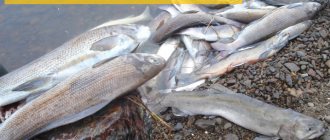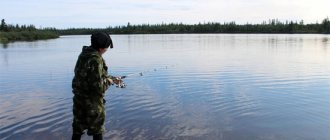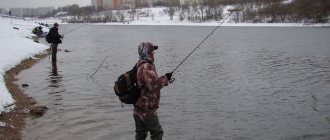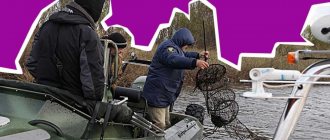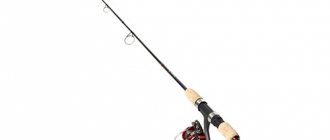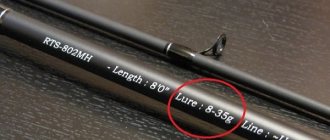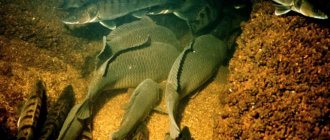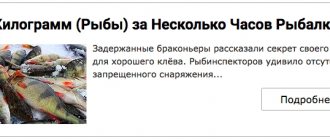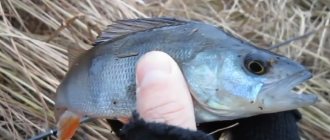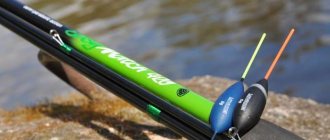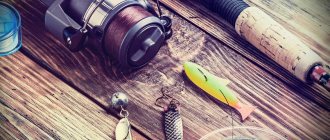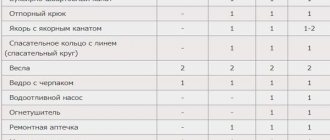Spinning fishing involves placing artificial baits that imitate a fry or sick fish in the water column by winding a reel. This kind of bait play provokes predatory fish (perch, pike, pike perch and others) to bite.
Here is a guide to spinning fishing for beginners. Here you will learn how to choose spinning gear - rod, reel and line. To start, choose the most suitable bait for your fishing conditions. We will help you understand which predator to focus on first and give detailed instructions on your fishing plan so that you are sure to catch a predator with a spinning rod.
Choosing a target and fishing location
A beginner should start fishing with the most common types of predatory fish: perch and pike. In this article we will focus on both of these fish species. Let's start with coastal perch fishing and continue with pike.
Let's decide on the choice of fishing location. Ideal places are small ponds and lakes. Things are more complicated with small rivers and it is much more difficult to catch perch and pike with a spinning rod from the banks of large reservoirs, for example on the Volga.
| Perch | Pike | |
| Pond | Perfect. Most ponds contain bass, the only difference being their size and population density. | A good place. The easiest way to catch pike is in a pond in places rich in vegetation. |
| Lake | Also common. A good option for fishing from the shore. | As in the case of perch, if there is vegetation and snags, it is much easier to find pike here. |
| small river | Not all rivers are suitable for fishing. Make sure there are depths of 1 m and above. You will have to actively search for the predator. | Not all rivers have pike. You need to make sure it is available. It can give itself away with strong splashes on the surface of the water. |
| Shore of a large reservoir | You can catch perch, for example, from the bank of the Volga, but you will have to look for its sites and use a medium or heavy class spinning rod for jig fishing. | It is almost impossible to catch from the shore on the Volga. Check with us about promising places in your region. |
Conclusion: get ready to look for perch on the shores of small ponds or lakes. This is the most promising place for learning spinning fishing.
It is important to know! Perch is a predatory schooling fish that prefers to hunt near the bottom. Loves fresh, oxygen-rich water. Prefers active play of the bait (the higher the frequency of oscillations of the bait in the water, the better).
Russia
A huge country, which is located in the space from the Baltic Sea to the Pacific Ocean, in the spaces between the Arctic ice and the Black Sea subtropics. Only large bodies of water number in the dozens. Many wild and inaccessible, located in sparsely populated areas from the northern tundra to the high mountain lakes of Altai and the Caucasus. Among foreign fishermen, the most popular are tours to Kamchatka during the run of Far Eastern salmon, chum salmon, pink salmon and brown trout. The most interesting from the point of view of trophy fishing lovers are:
Rivers
- The Volga
is the largest river in Europe. It originates on the Valdai Hills and flows into the Caspian Sea. In the upper and middle reaches there are many cities located on the banks of the river, so the catches in these places are not particularly diverse. In the lower reaches of the Volga, a greater diversity of fish species appears. The summer fishing season begins in April and ends in October. In the spring, fish moving from the Caspian Sea to spawn are observed along the Volga. In those places they catch trophy catfish, pike, bream, and carp. In the lower reaches, sturgeon, sterlet, beluga and other fish species may be hooked. Fishing methods: spinning, all types of float fishing, feeder, classic donka.
- Akhtuba
is a tributary of the Volga, famous throughout Europe for trophy fishing for white fish. The most interesting time for fishing in these places is considered to be the period from mid-summer to October. In these places, both peaceful fish (carp, carp, bream, roach) and predators (asp, pike, pike perch, chub) are actively caught. Fishing methods: all types of float fishing, spinning, feeder, classic donk. - Siberian rivers - Ob, Yenisei, Lena and their tributaries
. Fishing in taiga rivers is not only exotic, but also productive. In summer and autumn, this destination is especially appreciated by foreigners. The fishing season begins at the end of May and ends in September. In the cleanest rivers they catch Siberian taimen, burbot, lenok, char, and brown trout. Fishing methods: spinning, fly fishing, donka. - The Amur
is a Far Eastern river along which Russia borders with China. The natural habitat of white and black carp, silver carp, snakehead and many other equally famous fish. The fishing season on this river begins in April-May, depending on the weather, and ends in September-October. In addition to the fish mentioned above, trophy specimens of Far Eastern brook lamprey, Amur and Pacific sturgeon, Siberian sterlet, chum salmon and pink salmon are caught in the Amur. Fishing methods: spinning, all types of float fishing, feeder, fly fishing, classic and vertical bottom fishing.
Lakes
- Lake Ladoga
is one of the largest lakes in Europe with depths of up to 250 meters. In winter, the lake does not always freeze completely. Therefore, ice fishing is quite dangerous. The summer fishing season starts at the end of April and ends in September. Trophy pike, perch, and pike perch are caught in the lake. Fishing methods: spinning, all types of float fishing, feeder, classic and vertical bottom.
- Lake Onega
famous throughout Europe for its winter fishing. The season starts in November and ends in March. The lake is home to the largest population of burbot in Europe. Moreover, as many as three species of this unique freshwater fish of the cod family coexist there. The lake is considered the largest habitat of freshwater smelt, a delicious and healthy fish. In addition to it, pike and perch, pike perch and whitefish are caught in those places. Fishing methods: spinning, all types of float fishing, feeder, classic and vertical bottom, girders and circles.
- Baikal
is the largest freshwater lake in the world. It is characterized by extreme (over 1000 meters) depths, crystal clear water and unique inhabitants. Fishing in these places is effective both in winter and summer. The highlight of fishing on Lake Baikal is considered to be the Baikal omul, but besides it you can catch trophy pike, Baikal burbot, sorog, taimen, grayling, and whitefish. Fishing methods: spinning, fly fishing, all types of float fishing (from fly fishing to match fishing), feeder, classic and vertical bottom fishing.
Sea fishing
This type of fishing, which is carried out both from the shore and on board a boat, is actively developing:
- In the Pacific Ocean basin
(Far East, Kamchatka, Sea of Okhotsk and Sea of Japan) fishing is carried out from late April to early November. In these places they catch squid, Pacific cod, yellowtail, greenling, sea bass, and Japanese hyperoglyph. Fishing methods: sea spinning, surf fishing, vertical bottom, vertical lure. - In the Azov-Black Sea basin,
intense fishing is observed from April to November. During this period, you can catch mullet, sea crucian carp, horse mackerel, wrasse, and sea bass in the sea. Fishing methods - sea spinning, pier fishing, rock fishing, vertical bottom, vertical lure. - In the northern seas basin (Kola Peninsula),
open water fishing begins at the end of May. Sea fishing in these places ends in early September. White Sea cod, sea bass, catfish, and flounder are actively caught in these places. Fishing methods - sea spinning, fishing from the shore with a bottom, fishing near rocks, vertical bottom, vertical lure.
Paid fishing is actively developing in Russia
. Many specialized tourist bases have been built, located directly on or near bodies of water. In the country, not only carp, grass carp and silver carp, but also all types of trout, whitefish, and sturgeon are bred on paid reservoirs. They are located in close proximity to large cities.
Disadvantages include the poorly developed road network in the country (and poor quality of road surfaces), long distances and lack of service, especially far from big cities. The downside is the presence of many untouched corners of nature where you can enjoy the views and catch unafraid fish.
Selecting a spinning rod
When choosing a first spinning rod, a beginner should pay attention to 5 characteristics: action, test, length, material, form factor. I recommend:
- Fast or medium action. The slower the action, the more of the rod that bends under load. For a beginner, a fast and medium action is enough to fish with all popular types of spinning lures and equipment.
- Test 3-15 g. This is a universal test that will allow you to fish with ultra-light baits (2-5 g) from the banks of ponds, and with heavier jig baits and equipment (12-15 g) even from the banks of a large river. Ultralight models (UL) are also suitable for a beginner if you want to fish exclusively on small ponds and rivers.
- Choose the length based on your future fishing style. If priority is given to light baits and fishing on ponds, then 1.8-2.1 m. Small rivers are the same. If you fish from the shore of large reservoirs and need very long casts, then the spinning rod can be extended to 2.4-2.7 meters.
- Material: composite or carbon - both are light and durable, the first is more expensive.
- And the form factor is whether the rod is telescopic or plug-in. Telescopic is more mobile, but often less sensitive. The plug takes up a lot of space, since most often it consists of 2 elbows. Choose what is more convenient for you. If there are no problems with transportation, then the choice is obvious - this is a plug. Otherwise, choose a high-quality telescopic spinning rod not made in China.
The Black Hole River Hunter telescopic spinning rod is a universal budget option for a novice fisherman.
Mobility, test 4-15 g, average action. I recommend taking a closer look at the following companies: Maximus, Major Craft, Aiko, Blue Bird, Shimano, Salmo. The last 2 Japanese manufacturers often produce more expensive, but also more reliable and high-quality spinning rods.
Coil
The key feature of spinning tackle is the presence of a spinning or multiplier reel. And if the multiplier should be considered by more experienced spinning players, then the inertialess spinning rod is ideal for a beginner. By the way, most advanced anglers use spinning reels. They just have slightly different advantages with the multiplier.
Select a reel based on the length of your spinning rod and the thickness of the fishing line.
- For reels of 1.8-2.1 meters, reels with a spool size of 1500 are suitable.
- 2.4 meters – 2000-2500.
- 2.7 meters – 2500-3000.
What is the spool size? This is the amount of fishing line in meters with a diameter of 0.01 mm that will fit on this spool. If the spool size is 1500, then 1500 meters of fishing line with a thickness of 0.01 would fit on the spool of this spinning reel. But you are unlikely to find such a thin fishing line or cord. Minimum 0.02 mm (Berkley Nanofil), and this is rather an exception. If we take the normal braid thickness of 0.1 mm, this means that the reel will hold as much as 150 meters of fishing line. Which is quite enough even when fishing from the bank of a large river.
a friction brake on any spinning reel. It allows you to unwind the line from the reel when there is too much resistance from the fish or when there are strong snags on snags, so that the line does not break under load. In spinning fishing, the front clutch is more convenient. The rear one is usually used when fishing with a feeder or when fishing for carp. Please take this into account.
The number of ball bearings must be 6 or more. This ensures that all the most important structural elements of the reel are reliably lubricated and run smoothly.
Editor's Choice:
Cheaper:
Ryobi Excia 2000 – 4500 rub.
More expensive:
Daiwa Emeraldas 2000. From 25,000 rubles.
Write about your favorite models of spinning reels in the comments.
Other features of spinning fishing
As for schooling predators, you can make another cast to a specific place immediately after catching the trophy. Surely you can count on a new bite. But with the same pike, leading a solitary lifestyle, everything is a little more complicated. The fact is that pikes have their own hunting grounds and do not stand close to each other. This means that after catching a predator, the area remains empty for some time, which means there is no point in catching here. Although every rule has its exceptions!
Don’t forget about the possibility of using tandem baits. Quite often, such baits allow you to catch fish even where they usually don’t bite. You can attach a twister to the tee of an oscillating spoon. This trick will allow the fisherman to almost double the effect of the bait. Of course, this will have a positive impact on the overall fishing performance.
A beginning spinning angler should definitely take a landing net with him when fishing. Since without this accessory it will be very difficult to remove a large predator to the shore or drag it into the boat. In addition, you should take care of purchasing such fishing accessories as an extractor and a yoke . Using these tools, you can quickly and safely remove the hook from the toothy mouth of the predator.
With the help of a boat you can reach those places where other anglers do not fish. Of course, in such untouched places the predator is more careless, and its concentration here is most likely high. So the fisherman can count on an increased catch.
A fishing gadget such as an echo sounder makes it possible to scan the bottom relief in the fishing area and even see individual large fish. Such an ace in the sleeve of a spinning angler will certainly allow him to achieve good results when fishing.
At first glance, it may seem that fishing with a spinning rod requires long and painstaking study. But as soon as you catch the first trophy, excitement comes into play. And after that, the spinner begins to improve his fishing skills by leaps and bounds. So a beginner can very quickly become a real spinning fishing professional!
Line selection
In spinning fishing, all 3 types of fishing line are used: monofilament, braided (braid / cord), fluorocarbon. But in 90% of cases you can forget about monofilament and limit yourself to just braided line, and if you fish with silicone jig baits and tie spaced rigs with leashes, then you will also need fluorocarbon.
- Monofilament line stretches. This is the main disadvantage and the reason why it is not popular among spinners. The spinning fishing technique involves constant contact with the bait by feeling the tip of the rod. If the line stretches, you simply won’t feel all the touches of the fish, the touches of the bottom, and you won’t understand what the nature of the bottom is. And all this is important.
- Braided line is ideal for spinning fishing. It practically does not stretch, which allows you to feel even the weakest bite at the tip of the rod. It has increased strength compared to monofilament, but is more expensive. Nevertheless, our choice is wicker.
- Fluorocarbon fishing line is famous for its invisibility in water and its hard feel (does not hold its shape well when bent). All this is very suitable for a spinning angler, if you tie spaced rigs for fishing with silicone baits. True, fluor has a drawback; it is less durable than its visual counterpart, monofilament. Therefore, try to take its thickness with a margin of 0.1-0.15 mm. If you are using 0.1 mm braid, then you need 0.25 mm fluorocarbon.
To begin with, we will have enough braided fabric. Thickness 0.1-0.14 mm. But just in case, buy fluorocarbon from the fishing store. Thickness 0.25-0.28 mm.
Braided line is the best choice for main line. For example, Sunline Super PE.
Basic lures for spinning fishing
To be fair, it should be said that a novice angler must understand not only the main types of lures for spinning fishing, but also the methods of fishing with them. Because the design features of various baits leave a huge imprint on the way they are used.
Oscillating spinners
The simplest bait, both in terms of design and ease of use, can be considered an oscillating spoon. This lure is a stamped piece of metal that is equipped with a treble hook. When retrieving, the spoon moves from side to side and rolls from side to side, thereby attracting predatory fish. This type of bait should be cast either with straight, uniform reeling, or by alternating rotations of the reel handle with pauses. Either way, both of these strategies will lead to success.
Spinners
But the rotating spoon has a relatively complex design. But it’s very easy to catch! You just need to cast to the point you like, let the spoon go deeper and begin to smoothly and evenly reel in the fishing line. At the first revolutions of the reel handle, the petal of the spinner starts, which is easily diagnosed by the increased resistance. You should try to move the lure as slowly as possible. Literally on the verge of the petal stopping. It is this type of wiring that most often attracts predatory fish. But when there is a pause, the spinner simply stops working, so it should only be carried out using continuous wiring.
Silicone baits
A variety of silicone baits are used primarily in combination with special weights called jig heads. These weights are equipped with a hook. The most popular silicone baits are twister and vibrotail. The first of the baits is an imitation of a worm. The second bait imitates a small fish. In both cases, the main working part is the movable tail. When fishing with jigs, step-by-step fishing is used. In essence, this is the same wiring with pauses, but during the pause the bait must be allowed to completely sink to the bottom, after which it is raised above it. Then the next cycle follows and the bait again finds itself on the bottom. The jig performs best when catching pike perch and catfish. But any other predators do not miss the soft silicone bait, carried out using stepped wiring.
Selection of baits
The following baits are ideal for catching perch with a spinning rod:
Rotating spoons (spinners) with a petal size from No. 0 to No. 2. The most common company is Mepps. It has a high-frequency rotation of the petal, which perch really likes.
Small twisters on a jig head in bright red, yellow, white colors with a large sailing tail. To begin with, take a small size - the total length with the tail is no more than 3 cm. This may seem like a small bait to you, but a medium-sized perch bites well on this, and there will be a lot of idle bites past a large twister.
The photo shows 2 types of silicone twister rigs on a hook with a sinker and 1 on a jig head.
- The twister is mounted on a jig head.
- A hinged connection between a Cheburashka sinker and a regular straight hook on which a twister is mounted.
- Hinged connection of a Cheburashka sinker with an offset hook and a twister. This is the most convenient and catchable option due to its maximum mobility due to the hinged joint, as well as maximum maneuverability even in the grass, since the offset hook tip is deepened in the body of the twister.
We can stop at this point. But if you want to continue to gain new experience on your first fishing trip, then try:
Small wobblers. For example, Kosadaka Mirage XL 50F.
Small vibrators , for example, Kastmaster.
Separated rigging lead (you will have to knit it yourself; it is difficult to find a ready-made one on sale, and the quality will not be good enough).
Composition of this equipment:
- At the end of the main line there is a sinker from 5 to 12 g, depending on the casting distance and fishing depth.
- A fluorocarbon leash 1 meter long is tied 20 cm from the sinker higher up the line, and at its end there is an offset hook with a small twister.
This is an advanced level, so we will discuss the details of fishing with a retractable leash in a separate article. The advantage of the equipment is the very smooth movement of the twister in the water, its slow sinking to the bottom during stepwise wiring. We will talk about it further.
We collect the tackle and attach the bait
We have already written a detailed article for beginning spinning anglers about completely assembling a finished spinning rod and attaching the bait in various ways. Read how to equip a spinning rod. After reading and repeating all the steps, you can already move on to the fishing process.
In short, you need:
- Attach the reel to the assembled spinning rod.
- Wind the line onto the reel.
- Thread the line through all the rings.
- Tie a swivel or knotless clasp to the end of the braid.
- Attach bait.
Looking for bites
We bought everything we need and are ready to go fishing. You need to find the right place on the pond. Perch loves fresh water, so the best places to start are ponds and lakes, namely the places of these reservoirs where there is an influx of new fresh water from small streams or rivers.
On a completely random map, I showed an example of a stream flowing into a pond. This is a promising place for catching perch, if it is found in this reservoir.
First cast
Throwing bait with a spinning rod is very simple.
- When the line layer is folded back, the line flies off the spool, therefore the bait at the end of the line falls to the ground. Tighten the reel handle and, if necessary, open the line guide so that the distance from the bait to the tip of the rod is 1 meter. Don't reel the bait too close (or too far) to the tip. 1 meter is ideal.
- Now move the rod to the side. Right-handed to the right, left-handed to the left. With your index finger, press the line that comes out from under the line guide and goes to the first largest ring. By pressing the line with your finger, you can open the line guide and nothing will happen. Thanks to the fact that you hold the line with your finger, it does not unwind from the spool.
- Swing the rod and cast in the desired direction, and at the very last moment (even a little earlier, at 90% of the movement), release your finger. Thanks to inertia, the bait will fly in the direction you chose, since you removed your finger and nothing prevents it from winding the line from the spool. That's the whole cast.
- Now that the bait has touched the water and is sinking, position the rod to the side, perpendicular to the direction of the line going to the bait.
- A second after the bait touches the water, close the line cover. This will ensure tension on the line from your spinning rod tip to the bait.
- As long as the line is stretched between the tip of the rod and the water, the bait continues to sink. But as soon as the line sags, this is a signal that your bait is on the bottom.
- Give a small jerk with the rod and start reeling.
Fishing process
Spinning fishing involves constantly casting bait and retrieving it underwater. There are several types of spinning rods. For a novice fisherman, 3 options are enough:
Uniform. You throw the bait (most often a spinner, less often a wobbler or silicone) at 20-50 meters. Wait for it to reach the bottom. Make a jerk with the rod and begin a uniform retrieve. You choose the speed yourself. But keep in mind that most turntables and twisters are designed for a certain minimum speed, below which the petal will not spin and the tail of the twister will not play as expected. Before casting into the distance, move the bait in the water and find out at what speed of reeling you can visually see that it is “spinning” as needed.
Stepped. Used when fishing with jig baits. You make 1-2 turns of the coil, then stop. Wait until the bait falls to the bottom (usually 1-2 seconds), then again 1-2 turns. The number of revolutions, their speed, pauses between windings - this is what you can and should experiment with in step wiring. When biting passively, do everything more slowly and smoothly. And vice versa, when the predator is active, you don’t even have to wait for the bait to fall to the bottom.
Stop & Go. Popular when fishing with spinners and spoons. It’s similar to a stepped one, with the only difference being that you don’t have to wait for the bait to fall to the bottom. You can also not abruptly complete the reeling, but simply slow down the pace of winding the line onto the reel.
We'll look at the rest of the wiring in the advanced spinning guide.
Fishing technique and landing
The jig fishing technique is that the jig bait is thrown as far as the tackle allows. After this, you need to wait until the bait sinks to the bottom. This moment is determined by the action of the rod tip, as well as by the tension of the fishing line. Further actions depend on what type of wiring the spinner has chosen.
Stepped type of wiring
This type of wiring is the most common and is used by almost all spinners. It is very important that the weight of the bait matches the test of the rod: it is very difficult to control the bait if the test of the rod is under 25 grams, and the bait is used up to 10 grams. And vice versa, if the rod test is up to 15g, and the bait is used under 25g.
Stepped wiring consists of 2-3 turns of the reel handle followed by a pause of 2-3 seconds. During the rotation of the handle, the bait comes off the bottom, and during a pause, it returns to the bottom. During such actions, you can play along with the tip of the rod.
Uniform wiring
Uniform wiring is more applicable to rotating spoons, since a pause here is completely inappropriate, due to the fact that the bait will not play so believably. But this does not mean at all that such wiring cannot be used when using jig baits or oscillating spinners. There are many examples of predators attacking baits moving at the same speed.
Fishing
A very interesting and important stage is fishing. For beginners, this may not be a feasible action if you don’t have a special landing net at hand. Popularly, such a landing net is called a catch, and sometimes you simply cannot do without it, especially if it is very difficult to approach the water.
If a bite occurs, then you need to make a hook: a sharp movement of the rod towards you, but not very sweeping, so as not to tear the hook hook. If a tee is used and the predator is caught on 2 or 3 hooks, then the predator is unlikely to leave, but if with one hook, then it is possible that the fish may leave, especially if it is a pike.
- Jig - fishing with jig baits or rigs using a load, playing with bait is carried out exclusively in the bottom layer, most often with stepped retrieve;
- Twitching - fishing with wobblers and poppers, making jerking movements with the tip of the rod;
- Spinnering is fishing with rotating and oscillating spinners, as well as a number of other baits; there is most often no play with bait as such, just uniform retrieval is carried out.
We fish all year round
The last recommendations for a beginner is to take into account the seasonal behavior of pike and perch. Based on the table below, select the most catchable time of day and fishing location to increase your chance of catching predatory fish.
| Perch | Pike | |
| Spring | The bite is activated starting in May. The closer to summer, the closer the perch is to shallow water. | Pike is one of the first to bite in the spring, usually at the end of April. |
| Summer | When it's hot, look for predators in the depths, but it's best to concentrate on fishing in the early morning hours. | All summer, pike stay in shallow water in areas with dense vegetation. |
| Autumn | In autumn, all predators begin to peck more actively, but the closer it gets to the cold, the deeper their camps. | Pike bite the longest in the fall until the cold weather. Search deep water with jigs. |
| Winter | Winter spinning is only relevant on ice-free, fast-flowing rivers. | |
Write about your spinning fishing experience, favorite baits and places to catch perch and pike.
Belarus
The smallest of the above countries. Belarus is located between Russia and Poland, Lithuania, Latvia and Ukraine. A country with a temperate climate. A country of rivers, swamps and lakes. A quarter of its territory is swamps (Polesie and the Berezinsky Nature Reserve). The country has a well-developed road network, reasonable prices for food and tourism services. Ecotourism is developing. Local residents are friendly towards foreigners. Fishing in this country does not require a license. The fishing ban applies only during the spawning season. True, even at this time fishing is allowed within the city limits with one fishing rod and one hook. Paid fishing is developed, especially near large cities. There are practically no exotic fish in Belarus. The waters of the country are home to fish familiar to most countries of Eastern Europe:
- White fish: bream, carp, crucian carp, carp, large roach.
- Predator: pike, asp, perch, pike perch, catfish, chub, burbot.
There is a good website “Fisherman's Map of Belarus”, where you can find out about many fishing spots.
Rivers
In this relatively small country, three large rivers flow, fishing on which is completely free.
- Dnepr
. Despite the fact that the Dnieper enters Belarus from the territory of Russia and then goes into the territory of Ukraine, the Dnieper is considered the largest, deepest river in Belarus. The largest tributary of the Dnieper in Belarus is the Berezina. This river is famous for its large catfish. Large carp and bream are often found. - Pripyat
is a notorious river, often mentioned in connection with the Chernobyl nuclear power plant disaster. It flows through the low-lying, swampy south of the country (Polesie) and flows into the Dnieper. The least accessible river for tourists, which has been “resting” from the influx of fishermen for almost thirty years. As a result, fishing on the river in these places allows you to catch large predators (catfish, pike and perch). They catch large chub, asp, bream and carp.
- The Neman
is a fairly clean and accessible river in Belarus for tourists. In its lower reaches it goes to Lithuania. It flows into the Baltic Sea in the Kaliningrad region. After the construction of the Grodno hydroelectric power station dam, the reservoir formed by this dam became the most visited part of the river. The Neman is famous for large pike perch, bream, large crucian carp and carp.
Each of these rivers is fed by numerous, sometimes quite deep tributaries, which are distinguished by the purity of their water. In the tributaries you can additionally catch Baltic salmon, brook trout, and brown trout. All types of float fishing, feeder, classic donka, spinning are considered not prohibited methods of fishing on the rivers of Belarus.
Lakes
The lake network of Belarus is interesting for fishermen. The south and east of the country are represented mainly by large artificial reservoirs. To the north and west of Minsk there are mainly natural lakes of relict origin.
- Braslav Lakes
are a network of natural lakes in the north of Belarus, which are distinguished by the purity of their water. They are considered the most interesting attraction of the country for fishermen. It is there that most often you come across trophy specimens of crucian carp, pike, and perch. - Naroch
is the most famous, deepest and once cleanest lake in Belarus. A resort area with a well-developed tourist infrastructure around it. In the reservoir, in addition to the peaceful and predatory fish familiar to most fishermen, on Naroch you can catch eel, whitefish, and lake trout.
- A network of lakes in the Grodno region (Kan, Beloe, Molochnoe)
. In these places, fishing for carp, bream, crucian carp, tench and large roach is considered common practice. The reservoirs are inhabited by pike, perch and pike perch.
Artificial reservoirs
There are many reservoirs in the country, but the most interesting from the point of view of trophy fishing are:
- Zelva Reservoir
is one of the oldest reservoirs in the country. The place where the national carp and pike fishing championships are held. - The Minsk Sea
is one of the largest and most accessible reservoirs in the country, located near the capital of the country. A reservoir where large bream and carp are caught. - Warm canal in Beloozersk
. The canal serves as a heat exchanger at the Beloozersk Hydroelectric Power Station, the country’s largest power plant. Even in winter, the water temperature in the canal exceeds 15 degrees. Here you can catch crucian carp, perch, carp and grass carp all year round.
Paid fishing
widely developed in Belarus. In almost every region you can name at least a dozen such reservoirs. They differ mainly in size. Mostly carp, grass carp and silver carp are caught there, which feel relatively comfortable in a fairly cool climate. A few bodies of water (for example, Adam's Lake near Grodno) specialize in trout breeding, which is allowed to be caught for a fee.
